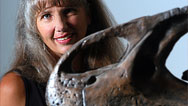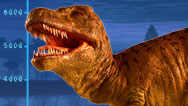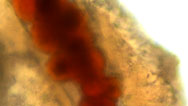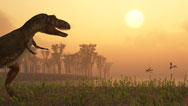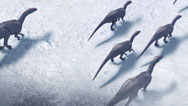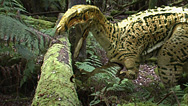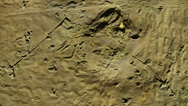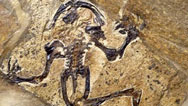
Bigger Than T. rex
Meet Spinosaurus—the lost killer of the Cretaceous and the world's largest carnivorous dinosaur ever. Airing September 2, 2015 at 9 pm on PBS Aired September 2, 2015 on PBS
- Originally aired 11.05.14
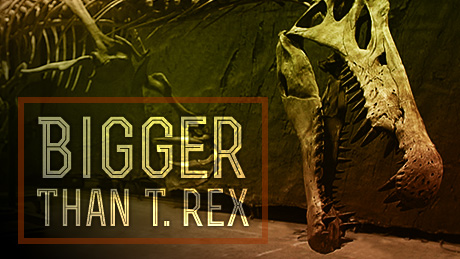
Program Description
Transcript
Bigger Than T. rex
PBS Airdate: November 4, 2014
NARRATOR: It's one of the most mysterious dinosaurs ever discovered: head like a crocodile, meter-long jaws, a spectacular sail, and an overall body larger than T. rex.
NIZAR IBRAHIM (University of Chicago): There is no animal alive or extinct, that we know of, that looks anything like Spinosaurus.
NARRATOR: Spinosaurus: only one skeleton has ever been found, and, in a single night, it was destroyed.
HANS-DIETER SUES (National Museum of Natural History): It was a catastrophic loss to science, overall.
NARRATOR: Now, after a century of searching, a new skeleton has emerged from the Sahara.
MATT LAMANNA (Carnegie Museum of Natural History): When this skeleton is revealed, it's going to change our understanding of this animal in pretty fundamental ways.
NARRATOR: And, already, it's pushing the limits of what scientists thought dinosaurs could do.
PAUL SERENO (University of Chicago): We're going to be figuring out things, as we look at the bones, that we never dreamed possible in a dinosaur before.
NARRATOR: From the deserts of Africa to Nazi Germany, from the underground fossil trade to the cutting edge of digital paleontology, can we solve the mystery of the world's biggest predator?
PETER DODSON (University of Pennsylvania): I think Spinosaurus is ready, now, to occupy its place in the pantheon of dinosaurs.
NARRATOR: Bigger Than T. rex, right now, on this NOVA/National Geographic special.
The Moroccan Sahara: seven hours east of Marrakech, a remote, barren desert, but hidden beneath the endless sands lies a treasure trove of fossils.
Morocco's ancient rock has preserved an amazingly complete record of life here, from prehistoric insects and sea creatures to crocodiles and dinosaurs. Today, they're a precious resource. The Moroccan fossil trade brings in tens of millions of dollars a year.
NIZAR IBRAHIM: What you have here is a little bit like a geology book, you know? So you have fossils, you have trilobites, you have corals, minerals—it's literally the history of life on our planet, laid out on these benches.
NARRATOR: That's why paleontologist Nizar Ibrahim, is here. He's come to Morocco's fossil capital, Erfoud, in search of one of the rarest, most mysterious animals ever discovered, a killer even larger than T. rex. Its name is Spinosaurus.
HANS SUES: Spinosaurus, even by dinosaur standards, is one of the strangest, weirdest creatures anyone can imagine.
PETER DODSON: This animal's a fabled beast. I make the comparison to Nessie, the Loch Ness monster, or the Sasquatch or the Abominable Snowman. Yes, there are pictures in books, but we can't put our hands on the real fossils.
MATT LAMANNA: Spinosaurus is one of the great mysteries of the dinosaur world. This is an animal that we know was enormous, we know was very strange, but, short of that, we don't know that much about it.
NIZAR IBRAHIM: Spinosaurus tooth.
NARRATOR: Sharp, conical and very large teeth, discovered all across North Africa, offer telltale signs of this powerful predator. The problem is, very few Spinosaurus bones have been found to go with them.
NIZAR IBRAHIM: Spinosaurus fossils are very rare. Teeth are actually a fairly common find, but an associated skeleton? Several bones that belong to the same animal? That's something that happens once every hundred years.
NARRATOR: Nizar, a specialist in North Africa's ancient fossil beds, has spent the last decade scouring museum collections and fossil shops, around the world, for elusive Spinosaurus bones.
NIZAR IBRAHIM: I was looking at everything, just hoping to find something that someone hadn't seen before. So, I was starting to piece together a basic outline of the skeleton, but there were so many missing parts, it was very frustrating.
NARRATOR: Frustrating, but not unusual for North Africa. Fossilized remains of dinosaurs have been notoriously difficult to find here, because of the vast distances and harsh, desert conditions.
PAUL SERENO: It brings new meaning to, you know, "a needle in a haystack."
NARRATOR: Nizar recently joined forces with paleontologist Paul Sereno, a leading expert in African dinosaurs.
PAUL SERENO: You know what it's like digging in some places in North America and China? I mean, it's littered with bones. We've got dozens of skeletons of T. rex. In Africa, it's a totally different story. You have this great Sahara Desert, which extends, literally, in different directions, thousands of miles from where we are sitting here, many without roads. You could spend a week here, easily, with an entire team and not find one piece of bone. It's a challenge.
NARRATOR: Sereno has had more luck than most. In 1997, he discovered a predator named Suchomimus, in nearby Niger. The name means "croc mimic," because of its long, narrow snout.
He also found the only well-preserved skull of Carcharodontosaurus, the shark-tooth lizard.
PAUL SERENO: That was an incredible find, this giant T.-rex-sized skull. It had these stabbing six-inch teeth.
NARRATOR: Together with the remains of giant crocodiles, flesh-eating birds and Spinosaurus, the few fossils found here indicate that 95-million years ago this may have been the most dangerous place in the history of Earth, a habitat of giant carnivores, covering much of North Africa.
MATT LAMANNA: This is possibly unprecedented in Earth history. Big predators tend to be rare. It takes a lot of food to feed a population of large carnivorous animals.
NIZAR IBRAHIM: It just seemed like a place that shouldn't really exist.
NARRATOR: It's a mystery Nizar believes he can solve, if he can just find another specimen of the enigmatic Spinosaurus.
But before venturing further into the desert, Nizar's quest takes him to Germany and the castle of an eccentric aristocrat, Ernst Stromer. The little we know about Spinosaurus begins with him.
NIZAR IBRAHIM: Ernst Stromer was a German paleontologist. He was really an explorer that wanted to find fossils on virgin grounds.
NARRATOR: The year is 1910. Fossils are hard to come by in Germany. But across the Mediterranean, in the deserts of Egypt, come reports of vast formations of ancient rock. Stromer is eager to explore them, not for dinosaur fossils, but for early mammals, to chart their diverse evolution.
With the help of an Austrian fossil hunter, named Richard Markgraf, he scopes out several locations. The most promising, according to their crude geological maps, appears to be the Bahariya Oasis, on the edge of the Sahara Desert.
NIZAR IBRAHIM: Stromer was used to going to nice restaurants in Munich, living in a castle, and here he is in the middle of the desert. It's hot. He's hungry. He's not happy with the speed of the camels, and it's a really difficult situation for him.
NARRATOR: Ever the meticulous scientist, Stromer recorded his many travails. His granddaughter, Rotraut, still has his many journals and photographs.
ROTRAUT STROMER (Granddaughter of Ernst Stromer): My grandfather didn't throw anything away. If every generation were to do that, the biggest castle would soon be full.
NARRATOR: Half German and half Moroccan, Nizar feels a special connection to Stromer. His works offer valuable insight into a man whose discoveries have been largely overlooked.
NIZAR IBRAHIM: The fact that Ernst Stromer was a great paleontologist, one of the best paleontologists in the world, had been forgotten, was something that I thought was really tragic. So, from a relatively early age, I thought, well, "One day, you know, we're going to restore his legacy."
NARRATOR: Stromer's journals make it easy, documenting every step of his three-week desert trek. He writes of rainstorms and sandstorms, of frustrations with his crew. But when he finally reaches Bahariya, his luck begins to change. Stromer describes some of the first-ever evidence of the Sahara's turbulent past, and the creatures that lived here.
ERNST STROMER (DRAMATIZATION FROM JOURNAL): I find red layers preserving shark fin spines, fish teeth, and to my joy, also small vertebrae of reptiles.
NARRATOR: And then, at 8:40 a.m., on January 18,…
ERNST STROMER (DRAMATIZED READING FROM JOURNAL): I find three large bones lying next to each other. The better one is probably a thigh bone.
NARRATOR: …poking out of the rocks, Stromer finds enormous thighs, ribs, vertebrae and claws. They're not early mammals, but something much bigger.
ERNST STROMER (DRAMATIZED READING FROM JOURNAL): Apparently, these are the first of Egypt's dinosaurs. I don't know how to conserve such gigantic pieces!
PAUL SERENO: Stromer wandered into an oasis and wandered out with the first dinosaur bones, really, good dinosaur bones, from Egypt. He didn't even know, grossly, how old these beds were. And he was going for a different reason, and he found some of the weirdest dinosaurs on the planet. The important thing is that he realized it.
NARRATOR: Stromer changes course from mammals to dinosaurs and dispatches Markgraf on more fossil-finding expeditions to Bahariya.
Together, they introduce many new dinosaurs to the world: a large plant-eater, Aegyptosaurus; killer carnivores, Bahariasaurus and Carcharodontosaurus; and, the biggest, most bizarre dinosaur of all.
In 1912, Markgraf makes a remarkable find in Bahariya's 95-million- year-old sandstone. Long chunks of spine, massive ribs, pointy teeth and a well-preserved lower jaw.
Back in Munich, it takes Stromer several years to piece this unique creature together. He describes an animal with jaws like a crocodile; smooth, cone-shaped teeth; razor-sharp claws; six-foot spines, comprising a magnificent sail; and an overall size larger than any other predatory dinosaur, including T. rex, which had only recently been discovered in North America.
PAUL SERENO: Stromer was amazing at how well he understood this animal from the pieces that he had.
NIZAR IBRAHIM: He realized that he was dealing with something that was like nothing else that had been found anywhere else in the world.
NARRATOR: In 1915, Stromer dubs his animal Spinosaurus aegyptiacus, the "spined lizard of Egypt."
For the next several decades, the skeleton becomes a popular attraction at Munich's Natural History Museum, but that all changes when the Nazis rise to power.
An outspoken critic of the regime, Stromer suffers terribly during the war. All three of his sons are sent to the frontlines. Only one, his granddaughter Rotraut's father, survives. And if that isn't enough, even Stromer's life's work becomes a casualty of war.
NIZAR IBRAHIM: We're in Munich here, [German street name] 51.
This is the exact place where the Spinosaurus skeleton was mounted. It was a great collection, one of the biggest natural history collections in Europe, so Stromer was very proud of the things he had found. And he tried very, very hard to have them put into a safer location.
NARRATOR: But the museum director, a dedicated Nazi, refuses to move the fossils, and on the night of April 24th, 1944, hundreds of Allied bombers drop thousands of bombs on Munich. The museum is destroyed. Spinosaurus is lost to history.
NIZAR IBRAHIM: This is the only surviving image of the mounted Spinosaurus skeleton.
Just imagine you spend decades of your life doing research, and then, in one night, everything is destroyed.
The loss of his sons, of course, was the biggest loss in his life, but the dinosaurs were a very close second. Those were unique specimens, and I think he knew that it was very difficult to find fossils in the Sahara. And he was right.
NARRATOR: Stromer died in 1952. His journals and photographs survive, but without skeletons to grace exhibit halls or fossils to study, his dinosaurs are overshadowed by T. rex and other, more familiar, beasts.
MATT LAMANNA: Not having the original Spinosaurus skeleton is a tremendous loss to dinosaur paleontology. We can't go and examine his observations directly.
HANS SUES: We had this fleeting glimpse of something, and then it's gone. I mean, this is as frustrating as it gets for a paleontologist.
NARRATOR: Sixty years later, Spinosaurus and the terrifying world it lived in, is as mysterious as ever. Over the decades, a few Spinosaurus bones have turned up from across North Africa: teeth, vertebrae and this partial snout.
They're isolated pieces, mostly dug by amateur fossil hunters and sold to private collectors on the black market. But if scientists don't know where they come from or what they were attached to, they hold little value.
PAUL SERENO: We were tempted and teased by teeth and little tiny pieces and then a snout, here, but no skeleton, nothing associated, nothing bone to bone. Nothing to piece together more than what Stromer had done a hundred years ago.
NARRATOR: But then, suddenly, everything changes. At the Natural History Museum, in Milan, Italy, Christiano Dal Sasso receives a large collection of bones from an Italian fossil trader.
He's told they're from Morocco, likely spirited out illegally. They all seem to be from a single specimen, and they bear a striking resemblance to Stromer's lost Spinosaurus.
Christiano quickly connects with Nizar, knowing he'd been obsessing over Spinosaurus bones for the last decade.
NIZAR IBRAHIM: They said that it's a large predatory dinosaur and that I should see it. So, I traveled to Italy, on my small doctoral-student budget, and I saw this really amazing layout of bones on a table.
NARRATOR: Tall spines, leg bones, foot bones, skull fragments: it was a collection of fossils even more complete than Stromer's.
NIZAR IBRAHIM: I was just amazed. It was, you know, I had difficulty breathing, you know? I was just thinking, "My god, is this what I think it is?"
NARRATOR: Convinced the skeleton is Spinosaurus, Nizar arranges to have all 60-odd bone fragments moved to Paul Sereno's lab, at the University of Chicago, to be systematically studied.
PAUL SERENO: When, finally, this specimen of Spinosaurus showed up, we were picking our jaw up off the ground. Nothing made sense.
NARRATOR: Sereno expected Spinosaurus to be similar to Suchomimus, the other meat-eater he had discovered in North Africa.
Suchomimus lived 15-million years earlier than Spinosaurus, around 110-million years ago. It, too, had a long snout, conical teeth and a sail. So Sereno determined that it was actually a cousin of Spinosaurus, but Spinosaurus had taken those adaptations to the extreme.
PAUL SERENO: We began to realize, pretty quickly on, that this animal was no ordinary dinosaur.
NARRATOR: The team could see, immediately, that some of the new Spinosaurus bones matched the ones in Stromer's old photographs, especially those characteristic spines. But now they had new bones that Stromer never had: flat feet, hand and thigh bones, pieces from the back of the skull, the makings of an animal more bizarre than even Stromer could have imagined.
NIZAR IBRAHIM: So, this is really the jackpot.
NARRATOR: But all these bones are missing one crucial bit of information: where they're from.
MATT LAMANNA: Most fossils from Morocco are found by private collectors and actually bought and sold on the open market, and so, when you do this, the critical contextual information is lost. To truly understand the dinosaur, we need to understand the rocks that it came from.
NARRATOR: Nizar has no idea where these bones originated, but as he studies them closely, he notices something eerily familiar. The cross-section of the spines have unusual lines running through them, perhaps fossilized traces of blood vessels. No one knows what they are, but, to Nizar, they're a smoking gun. He remembers seeing similar bones in Morocco, just a few years earlier.
NIZAR IBRAHIM: I thought, "This is something I've seen before. I've seen a small chunk of bone just like that one." And I thought, "Wow, I wonder if this is maybe the same specimen."
NARRATOR: If it is the same specimen, and the bones match, Nizar might be able to track down the fossil hunter who dug them up, the only person who could take Nizar to the exact spot the dinosaur was pulled from. It's a longshot, but worth a trip back to Erfoud.
Nizar has to rack his brain to remember details of the fossil dealer who first showed him the chunk of bone. He vaguely recalls a tall, mustached man in a white tunic.
NIZAR IBRAHIM: It became clear, very quickly, that that description fit many, many men in Erfoud. Everybody thought that I was crazy. This had never been done before. Rock and fossils had been described for many, many years, and nobody has ever been able to trace them back to the original site.
NARRATOR: With the help of British paleontologist Dave Martill and Moroccan Samir Zouhri, Nizar goes village to village, shop to shop, chatting up the locals for clues to the fossil-hunter's whereabouts.
NIZAR IBRAHIM: I'm trying to find a needle in a haystack. Actually, it's much bigger than a haystack. It's a needle in the Sahara.
NARRATOR: Given Morocco's vague export laws, Nizar needs to tread carefully. Dealers here are allowed to dig up and sell all the common fossils they want: trilobites, ammonites, even dinosaur teeth, but exporting rare fossils out of Morocco without a license is illegal. Even if Nizar does find the man he's looking for, there's no guarantee he'll agree to help.
NIZAR IBRAHIM: Those are some big teeth. There's some really nice specimens here, but it's all isolated pieces, so that's all they are finding here, no associated skeletons. This is not where our skeleton came from, that's for sure.
NARRATOR: The trail in the fossil shops is going cold. Nizar decides to head south from Erfoud, toward Morocco's ill-defined border with Algeria, where most of the country's fossils are found.
DAVE MARTILL (University of Portsmouth): Is he one of the diggers?
MAN: Yeah, he's one of the diggers.
DAVE MARTILL: Oh, excellent. He should know where he's going, then.
NARRATOR: Diggers here don't have any special training. With shovels and other crude tools, they bore tunnels straight into the rock, pulling out any fossils they can, often damaging them in the process.
HANS SUES: They're just digging to get out what's, in essence, strange looking rocks. They don't document the circumstances. They don't document, in most cases, where something actually came from.
NIZAR IBRAHIM: It's really like a Swiss cheese, lots of holes and openings. And, of course, there is no scaffolding, no support structures, and its pretty soft sandstone. People have died. And, of course, they are breathing in all the dust every day—very difficult work.
NARRATOR: Despite the risks, diggers depend on the income, and paleontologists depend on them, crude as their techniques may be.
NIZAR IBRAHIM: This is how most fossils are found. Most fossils are not found by professionals. You know, if they weren't doing this, there's nobody else out here collecting things in a systematic fashion.
NARRATOR: So far, there's no sign of the mystery fossil hunter.
Back in Erfoud, Nizar is ready to give up.
NIZAR IBRAHIM: My morale is very low. I'm just trying to figure out what to do next. You know, it's just being back at square one. And right in that moment, when I am at the very lowest point, this figure walks past me, and after just a few seconds it became clear that he was the man I was looking for. He was the one!
NARRATOR: Against all odds, the man actually remembers meeting Nizar several years ago. He recalls showing him a chunk of bone with lines running through them. And yes, he did dig up the rest of that skeleton.
NIZAR IBRAHIM: I can't believe my luck.
NARRATOR: Worried that the skeleton is now illegally abroad, the man insists that his identity be concealed. Nizar tries to convince him in Arabic to lead them to the dig site.
NIZAR IBRAHIM: He's concerned, because he thinks that if someone recognizes him, he might get into trouble. So, I explained to him that this is not a fossil dealer situation. I am studying these fossils. I want to know where exactly they came from, and they'll return to the country of origin.
NARRATOR: The man agrees, finally, to take Nizar to the site where the fossils were pulled from the ground.
After nearly an hour drive, most of it off-road, and a 30-minute trek up the side of a mountain, the dealer leads Nizar to a nondescript looking hole in a hillside.
Within minutes, in the fill surrounding the dig site, they discover fragments of bones and teeth, all but certainly Spinosaurus.
NIZAR IBRAHIM: This is amazing! I mean, this will take some time to sink in, but it feels really amazing, it feels really surreal.
NARRATOR: The dealer explains how it took two people, digging for two months straight, to get the skeleton out, and how he sold it to an Italian fossil dealer for the equivalent of 14,000 U.S. dollars.
NIZAR IBRAHIM: This is the best thing he's ever found. And he's never found anything even close to that, in terms of completeness. You find pretty bones, but never, ever a partial skeleton.
MATT LAMANNA: The fact that they were able to relocate the discovery site of the skeleton is remarkable, and is going to provide much needed info about the environmental context of Spinosaurus.
NARRATOR: Within months, Nizar rallies Paul Sereno, Christiano Dal Sasso from Milan, and colleagues from the U.K. and Morocco, to conduct a more thorough excavation.
PAUL SERENO: So this is it? Wow.
NARRATOR: Their goal now is simple: characterize the rock and landscape to see when and how Spinosaurus lived and, if they can, find more bones.
Rather than boring tunnels straight into the rock, as the fossil hunter did, paleontologists excavate from the top.
PAUL SERENO: This is the overburden, very hard rock over the layer that has the Spinosaurus bones, so we are widening this opening to the cave until we can get a surface here that is just about where the bones were found. We know they were found in a layer right down here, so to move this layer is the pay dirt, here.
NARRATOR: At the bottom of the hill, Dave Martill takes a different tack, sifting through the tons of fill the local digger already discarded.
DAVE MARTILL: All this is the overburden that the original guy who made the discovery threw to the side, while he was trying to excavate the bones. But I don't think he was looking carefully enough, so I'm going through all of this.
NARRATOR: He needs to pass a massive amount of material through his sieve, but after several hours, Dave strikes pay dirt: chunks of cone-shaped teeth, even a piece of jawbone that are all classic Spinosaurus.
DAVE MARTILL: So, even from small bits like that, I stand a chance of rebuilding the entire tooth, which is what I intend to do. It's just I have about three tons of material to sift through.
NARRATOR: The scientists scramble over the rocks for days, retrieving and assembling as many bits and pieces of the skeleton as they can. Christiano exposes one of Spinosaurus' characteristic spines, similar to the ones Nizar recognized years ago.
CHRISTIANO DAL SASSO (Milan Museum of Natural History): This is the same shape, same size of the specimen we already know well. It is another confirmation that this is the specimen we're looking for.
NARRATOR: As they piece together the bones, the scientists are also looking carefully at the rocks they come from. These layers comprise millions of years of geologic history. But can they reveal the habitat Spinosaurus lived in and how he survived alongside the other giant carnivores?
DAVE MARTILL: We're above the dig site, now, and we're looking at the cliffs that dominate this valley. And you can see beautiful stripes, gorgeous colors. Each one of these layers represents a change in the environment.
NARRATOR: Forests, lakes, rivers.
DAVE MARTILL: As we go down through each of the layers, we're going further and further back in time. And, eventually, we get down to the layer with our Spinosaurus.
NARRATOR: Buried along with Spinosaurus are very different kinds of fossils, ones you might not expect to find halfway up a mountain in the Sahara.
DAVE MARTILL: This is full of lots of shells. That's a little sea urchin.
NARRATOR: Sea urchins, mollusks…
DAVE MARTILL: Oh that's lovely. That's a nautilus.
NARRATOR: …fossils of marine animals dating back to the Cretaceous period, 95-million years ago. Back then, sea levels were over 100 meters higher than they are today. Much of this place was underwater, inundated by rivers and lakes and a massive ancient sea.
Fossils of similar age, found across North Africa, reveal that this lush ecosystem once stretched from here, in Morocco, all the way to Egypt. And Spinosaurus, along with the other giant predators, lived throughout all of it.
PETER DODSON: It's meat-eaters, meat-eaters and more meat-eaters. Here it is, this chamber of horrors, this scene of carnage and destruction. It's a very, very striking image.
NARRATOR: Problem is, it's a scene that continues to confound paleontologists. They've found all these fossils of carnivores from this period, but relatively few herbivores for them to eat.
PAUL SERENO: This is unheard of. There's too many predators, and when you look for the herbivores that are found in the formation, you really have a tough time. I mean, they are not only underrepresented in bones and teeth, but it's hard to find a herbivore footprint.
MATT LAMANNA: Stromer, himself, realized this puzzle. You know, there's all these big carnivorous things around, but nothing, you know, nothing obvious for them to eat.
NARRATOR: Unless they were eating something else.
DAVE MARTILL: There's another bivalve. There's lots and lots of bivalves.
NARRATOR: There are lots of shellfish in the fossil record, but also much larger sea creatures, like coelacanth, sawfish and lungfish: a perfect meal for any dinosaur that could catch them.
NIZAR IBRAHIM: We're not talking about small little salmon. We're talking about giant, 12-foot, 16-foot aquatic creatures. So one of these animals can easily feed an animal the size of Spinosaurus, no problem.
NARRATOR: That Spinosaurus, with its croc-like snout and conical teeth, was built to catch fish, is an idea even Stromer had considered.
DAVE MARTILL: Hey guys, guys! I've got some more of this tooth. Look at this.
NARRATOR: But in the history of paleontology, no one has found evidence that any dinosaur spent much of its life in water. If the new bones reveal Spinosaurus could, it would be the first, and that may help solve the mystery of North Africa's predators.
Back at the University of Chicago, the team quickly gets to work prepping and analyzing their new fossils, searching for any clues that Spinosaurus may have been aquatic. A full century after Ernst Stromer first studied and described Spinosaurus, Nizar and Paul finally have a new skeleton to study.
HANS SUES: Extremely exciting to hear that there was another skeleton, I was like, "Wow!"
MATT LAMANNA: Paleontologists have been awaiting the discovery of a new Spinosaurus skeleton, ever since the first one was destroyed.
NIZAR IBRAHIM: Now, just imagine if we lost all of this in a single night.
PAUL SERENO: Yeah, well, if there is any threat of a bombing raid here, we are hiding these fossils in the deepest cave.
NARRATOR: Just to be safe, the first order of business: copy the bones.
While Stromer described all of his bones by hand, Nizar and team use a C.T. scanner to digitize theirs in, bone by bone, producing a three-dimensional picture, accurate down to a fraction of a millimeter.
Back in the lab, paleo-artist Tyler Keillor then manipulates the hundreds of files and begins assembling a virtual Spinosaurus.
PAUL SERENO: We have, just now, moved into the digital age for dinosaur reconstruction, in the sense that you can go, literally, from a bone, to a digital model of the bone, to a digital skeleton, which you can simplify enough that you can make it move. You can make it walk. You can ultimately put skin on it.
NARRATOR: The skeleton is about 40 percent complete, a surprisingly high number compared to most specimens.
HANS SUES: Very few dinosaurs are known from a complete skeleton. There are lots that are known from a toe bone, a tooth, in most cases just distinctive enough to just tell you, yes, that was something there, but that's all there is.
NARRATOR: The digital model allows the team to take their skeleton much further, even incorporating some bones they don't actually have. Using scans of Stromer's original photos and resizing the bones to match their specimen, they can add in bits of jaw and spine that they're missing.
TYLER KEILLOR (University of Chicago): For the parts on the back that we didn't have, we're looking at Stromer's figures.
MAN: That's a Stromer specimen.
TYLER KEILLOR: Right. Those are Stromer's.
NARRATOR: Scans of Suchomimus, Spinosaurus's croc-snouted cousin, help fill out the skull.
TYLER KEILLOR: Here is, actually, the Suchomimus brain case, it fills in the back end very nicely.
NARRATOR: Scaling and incorporating bones from other specimens, they up their total from 40 to over 60 percent. Then it's a matter of fitting the bones together. Just getting the jaws to close properly takes 14 days.
MATT LAMANNA: Our knowledge of Spinosaurus comes from several different specimens. These aren't all the same size, so you can't just hodgepodge them together like some kind of giant Frankenstein. You have to build the digital model in the computer, so you can get all the proportions correct and give us a better conception of what the skeleton of one of these animals would have been like.
NARRATOR: Taken together—the new specimen, Stromer's, Suchomimus and other isolated bones—the digital skeleton reveals an animal every bit as extraordinary as Stromer imagined: 50 feet from snout to tail, the model confirms that Spinosaurus is the biggest predator ever to walk the planet, at least nine feet longer than the largest known T. rex.
HANS SUES: Size does matter biologically speaking, because you wonder, "What are the ecological circumstances that support such a large animal? And that gets back to Stromer's conundrum: how do you feed all these giant T. rex-sized predators.
NARRATOR: Stromer speculated that Spinosaurus could eat fish, but does that play out in the bones? The foot is a good place to start.
PAUL SERENO: It's got a flat bottom. I've never seen anything like this. The first time I set eyes on it, I said, what is this doing on this dinosaur?
NARRATOR: Most predatory dinosaurs scampered around with narrower feet and curved claws. This foot's completely flat.
PAUL SERENO: I've never seen anything else like it.
NARRATOR: To make sense of it, the scientists compare it to animals that are living—at least they were until relatively recently—starting with dinosaurs' closest living relatives.
PAUL SERENO: When you're starting with a predatory dinosaur, you think bird, as your living analogy. And you have to start there, because they're bipedal. For all we know, this dinosaur had feathers. We don't know for sure.
NARRATOR: Turns out flat feet are a handy feature for wading birds, like flamingos. They help keep them stable in wet sediment. In lush Cretaceous Africa, could Spinosaurus have used them the same way?
HANS SUES: Certainly it's a sensible interpretation to argue that the fairly flat foot would help an animal, particularly a large animal like Spinosaurus, walking over a soupy substrate, you know, you don't want to get stuck there.
NARRATOR: The flat surface may even help propel them through the water.
PETER DODSON: If, potentially, they use their feet as paddles, that's a whole other chapter. It reinforces the aquatic model for this animal. We may not be able to prove it in a court of law, but it certainly makes the probability of our inferences much, much more secure.
NARRATOR: For more evidence, the scientists look to Spinosaurus' other living relatives, crocodilians, which branched off from dinosaurs about 200-million years ago, animals like this 250-pound tame alligator, named Bubba. Bubba's a reptilian ambassador of sorts, allowing Paul and Nizar to get much closer to a large reptile than they probably should.
PAUL SERENO: Bubba is so kind to be able to lift up its hand and spread the toes, so you can really see the anatomy of a live crocodilian.
NARRATOR: The potential for webbing on its feet; its smooth, cone-like teeth…
PAUL SERENO: No bumps, no ridges, just basically a conical tooth, which is your basic fish-eating tooth.
NARRATOR: …its long, narrow skull…
PAUL SERENO: Crocodilians in general, when they become more fish-specialized, the skull becomes narrower and longer.
NIZAR IBRAHIM: Right, because you want as little water resistance as possible.
NARRATOR: …even the sensitivity of its snout…
PAUL SERENO: Every little polka dot on every scale is a special sensory cell. And we see all these openings on the front of the snout of Spinosaurus.
NARRATOR: …used for detecting motion in dark, murky water; the tail may have also helped; combined with the flat foot, it may have gracefully propelled Spinosaurus through the water, much like this animal.
PAUL SERENO: Whoa, there he goes. See, look at that. He uses the tail to get, to get going.
NARRATOR: The comparisons all point to a creature that was well-suited for getting around in the water and hunting fish. But what about that giant sail? Neither birds nor crocs have that.
From the old research journals, Nizar learns that Stromer had asked the same question, and had found one animal to compare it to: the crested chameleon.
PAUL SERENO: Look at this, at the…right where that ligament attaches, there is an expansion.
NIZAR IBRAHIM: That's right. They all have this broad base.
PAUL SERENO: Wow! That is absolutely neat.
NARRATOR: Sails evolved independently many times. Why isn't always clear. For storing fat? Shedding heat? Or, as a display to warn off predators or attract mates, a likely use for thin, narrow spines like these.
PAUL SERENO: I think this was display. It was to make yourself look bigger. Maybe there was competition for mates. Maybe the health, the size of your spine was an important factor.
NARRATOR: With the animal comparisons in and the digital model complete, there's only one thing left to do. The original bones will be repatriated to Morocco, but the team isn't confining its dinosaur to a computer forever. Thanks to machining facilities in Chicago and Toronto, virtual Spinosaurus is becoming the first life-sized predatory dinosaur fully realized from a digital model.
Seeing it for the first time, up close and personal, Paul and Nizar are confronted with just how massive Spinosaurus is and how bizarre.
PAUL SERENO: It's front heavy. You've got an eight-foot-plus sail, made of solid bone; you've got an elongated trunk, longer than most dinosaurs; you've got massive forelimbs, the most massive of any dinosaur; a long neck; and then a long skull, cantilevered on this side. Where's the balance?
NARRATOR: The skeleton towering over them forces the scientists to rethink how Spinosaurus got around.
NIZAR IBRAHIM: Looking at the skeleton, it was certainly, you know, very different from the mode of locomotion of any other dinosaur.
NARRATOR: It may have needed to use its long forelimbs for walking, a first for predatory dinosaurs, which so far have been strictly bipedal.
PAUL SERENO: While it hails from the two-legged dinosaur group of carnivores, it might be using those grabbing, grasping hands to walk. Otherwise it's going to fall on its lovely crocodile-like head.
NARRATOR: Of course, that's only when it was walking on land.
More likely, the finding is another strong indicator that Spinosaurus is different from any other dinosaur ever discovered. It appears to have forsaken the land, evolving, over millions of years, to thrive in water.
PAUL SERENO: It is one of the great mysteries of the dinosaur era, that every other major group has seemed to invade the water, and no dinosaur had ever done this. Never a dinosaur with a fin for swimming, never a dinosaur with anything we could point to, to say that was adapted for being in water. This is the first time, and it's really exciting.
NARRATOR: With this revelation comes a long-awaited explanation for how Spinosaurus and all the other monster predators of Africa's late Cretaceous competed for prey. Quite simply, they didn't.
Some large dinosaurs would have preyed on the region's limited meat supply. Spinosaurus may have only come up on land when it needed to, to lay eggs or move to another river. But, put it in the water, and it was perfectly adapted to hunt a boundless supply of fish.
MATT LAMANNA: If one of you is feeding on fish, and the other one is feeding on large dinosaurs, you're not in direct competition. And that means more large carnivorous animals can occupy the same habitat.
NARRATOR: Paddle-like feet and a powerful tail propel it through the murky, turbid water. Sensors in the snout help home in on prey. And at precisely the right moment, Spinosaurus does what its body is built to do.
NIZAR IBRAHIM: It all makes sense, you know, being big, having these strange proportions, having these unusual feet, this big sail. Once you really understand the world Spinosaurus lived in, all these adaptations make sense.
NARRATOR: And now, Spinosaurus makes sense too. It's been an odyssey spanning three continents and a hundred million years, but, finally, it can take its place among giants.
PAUL SERENO: It is the weirdest large…largest predatory dinosaur that we may ever find in our lifetime, but the saga behind this dinosaur—the man who was associated with the first bones, World Wars, the contraband fossils—it's a story that has so many dimensions, it's going to be hard to top.
NIZAR IBRAHIM: Spinosaurus hadn't really captured the public's imagination, because it just wasn't real. It was like a made-up dragon. But with this skeleton, you know, things are going to change. It's absolutely going to capture the imagination of the world.
NARRATOR: Spinosaurus, the world's first aquatic dinosaur: the largest predator is the lost killer of the Cretaceous.
Broadcast Credits
Stefan Oschmann
Matt Vogel
Jim Ball
Andrew Macdonald
Mustapha Adidou
Samir Akrab
Omar Ben Omar
Cedric Maury
Dr. Paul Sereno
National Geographic Digital Motion
Royal Tyrrell Museum
Simone Maganuco
Rotraut Von Stromer Baumbauer
Dr. Catherine Forster
Tyler Keillor
Davide Bonadonna
Jim Nesci and Bubba
University of Chicago
Acme Design, Inc.
Research Casting International
Milan Museum of Natural History
Bavarian State Collection for Paleontology and Geology
Samir Zouhri
Kingdom of Morocco
John Luker
Musikvergnuegen, Inc.
Rob Morsberger
Eddie Ward
A Production of NOVA/WGBH Boston and National Geographic Studios in association with National Geographic Channels International and ZDF
©: 2014 NGHT, LLC and WGBH Educational Foundation
All Rights Reserved
This program was produced by WGBH, which is solely responsible for its content.
- Image credit (Spinosaurus)
- © WGBH Educational Foundation
IMAGE:
Participants
- Cristiano Dal Sasso
- Milan Museum of Natural History
- Peter Dodson
- University of Pennsylvania
- Nizar Ibrahim
- University of Chicago
- Matt Lamanna
- Carnegie Museum of Natural History
- Paul Sereno
- University of Chicago
- Hans-Dieter Sues
- Smithsonian Institution www.mnh.si.edu/about/sues.html
Preview | 00:30
Full Program | 53:09
Full program available for streaming through
Watch Online
Full program available
Soon


